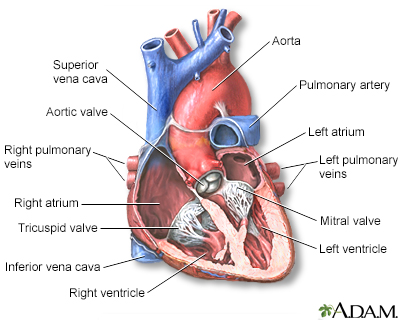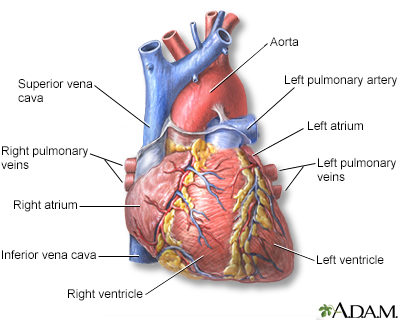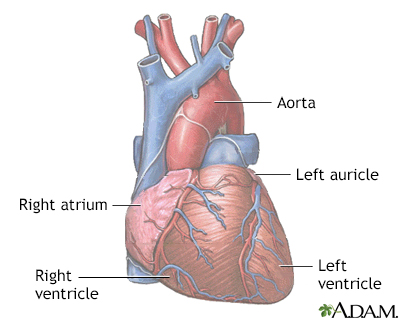Heart transplant
Cardiac transplant; Transplant - heart; Transplantation - heart
A heart transplant is surgery to remove a damaged or diseased heart and replace it with a healthy donor heart.
Images



Presentation

Description
Finding a donor heart can be difficult. The heart must be donated by someone who is brain-dead but is still on life support. The donor heart must be in normal condition without disease and must be matched as closely as possible to your blood and tissue type to reduce the chance that your body will reject it.
For this surgery, you are put into a deep sleep with general anesthesia, and a cut is made through the breastbone.
- Your blood flows through a heart-lung bypass machine while the surgeon works on your heart. This machine does the work of your heart and lungs while they are stopped, and supplies your body with blood and oxygen.
- Your diseased heart is removed and the donor heart is stitched in place. The heart-lung machine is then disconnected. Blood flows through the transplanted heart, which takes over supplying your body with blood and oxygen.
- Tubes are inserted to drain air, fluid, and blood out of the chest for several days, and to allow the lungs to fully re-expand.
Why the Procedure Is Performed
A heart transplant may be done to treat:
- Severe heart damage after a heart attack
- Severe heart failure, when medicines, other treatments, and surgery no longer help
- Severe heart defects that were present at birth and can't be fixed with surgery
- Life-threatening abnormal heartbeats or rhythms that do not respond to other treatments
Heart transplant surgery may not be used in people who:
- Are malnourished
- Are older than age 65 to 70
- Have had a severe stroke or dementia
- Have had cancer within the past 2 years
- Have HIV infection
- Have infections, such as hepatitis, that are active
- Have insulin-dependent diabetes and other organs, such as the kidneys, that aren't working correctly
- Have kidney, lung, nerve, or liver disease
- Have no family support and do not follow their treatment
- Have other diseases that affect the blood vessels of the neck and leg
- Have pulmonary hypertension (thickening of blood vessels in the lung)
- Smoke or abuse alcohol or drugs, or have other lifestyle habits that may damage the new heart
- Are not reliable enough to take their medicines, or if the person is not able to keep up with the many hospital and medical office visits and tests
Risks
Risks from any anesthesia are:
- Reactions to medicines
- Problems breathing
Risks from any surgery are:
- Bleeding
- Infection
Risks of transplant include:
- Blood clots (deep venous thrombosis)
- Damage to the kidneys, liver, or other organs from anti-rejection medicines
- Development of cancer from the medicines used to prevent rejection
- Heart attack or stroke
- Heart rhythm problems
- High cholesterol levels, diabetes, and bone thinning from the use of rejection medicines
- Increased risk for infections due to anti-rejection medicines
- Lung and kidney failure
- Rejection of the heart
- Severe coronary artery disease
- Wound infections
- The new heart may not work at all
Before the Procedure
Once you are referred to a transplant center, you will be evaluated by the transplant team. They will want to make sure that you are a good candidate for a transplant. You will visit many times over several weeks or even months. You will need to have blood drawn and x-rays taken. The following may also be done:
- Blood or skin tests to check for infections
- Tests of your kidney and liver
- Tests to evaluate your heart, such as ECG, echocardiogram, and cardiac catheterization
- Tests to look for cancer
- Tissue and blood typing, to help make sure your body will not reject the donated heart
- Ultrasound of your neck and legs
You will want to look at one or more transplant centers to see which would be best for you:
- Ask them how many transplants they perform every year and what their survival rates are. Compare these numbers with the numbers from other centers. These are all available on the internet at unos.org.
- Ask what support groups they have available and how much help they offer with travel and housing.
- Ask about the costs of medicines you will need to take afterwards and if there is any financial help in getting the medicines.
If the transplant team believes you are a good candidate, you will be put on a regional waiting list for a heart:
- Your place on the list is based on several factors. Key factors include the type and severity of your heart disease, and how sick you are at the time you are listed.
- The amount of time you spend on a waiting list is usually NOT a factor for how soon you get a heart, except in the case of children.
Most, but not all, people who are waiting for a heart transplant are very ill and need to be in the hospital. Many will need some sort of device to help their heart pump enough blood to the body. Most often, this is a ventricular assist device (VAD).
After the Procedure
You should expect to stay in the hospital for 7 to 21 days after a heart transplant. The first 24 to 48 hours will likely be in the intensive care unit (ICU). During the first few days after a transplant, you will need close follow-up to make sure that you do not get an infection and your heart is working well.
The recovery period is about 3 months and often, your transplant team will ask you to stay fairly close to the hospital during that time period. You will need to have regular check-ups with blood tests, x-rays, and echocardiograms for many years.
Fighting rejection is an ongoing process. The body's immune system considers the transplanted organ a foreign body and fights it. For this reason, organ transplant patients must take medicines that suppress the body's immune response. To prevent rejection, it is very important to take these medicines and carefully follow your self-care instructions.
Biopsies of the heart muscle are often done every month during the first 6 to 12 months after transplant, and then less often after that. This helps determine if your body is rejecting the new heart, even before you have symptoms.
You must take medicines that prevent transplant rejection for the rest of your life. You will need to understand how to take these medicines, and know their side effects.
You can go back to your normal activities 3 months after the transplant as soon as you feel well enough, and after talking with your health care provider. Consult your provider if you plan to engage in vigorous physical activity.
If you develop coronary disease after a transplant, you may have cardiac catheterization every year.
Outlook (Prognosis)
Heart transplant prolongs the life of people who would otherwise die. About 90% of heart transplant patients are alive 2 years after the operation. At 5 years, 75% of patients will still be alive after a heart transplant.
The main problem, as with other transplants, is rejection. If rejection can be controlled, survival increases to over 10 years.
Related Information
Heart failureStable angina
Cardiomyopathy
Liver disease
Type 1 diabetes
References
Chiu P, Robbins RC, Ha R. Heart transplantation. In: Sellke FW, del Nido PJ, Swanson SJ, eds. Sabiston and Spencer Surgery of the Chest. 9th ed. Philadelphia, PA: Elsevier; 2016:chap 98.
Freed JK, Pagel PS, Popescu W, Tawil J. Heart failure and cardiomyopathies. In: Hines RL, Jones SB, eds. Stoelting's Anesthesia and Co-Existing Disease. 8th ed. Philadelphia, PA: Elsevier; 2022:chap 10.
Heidenreich PA, Bozkurt B, Aguilar D, et al. 2022 AHA/ACC/HFSA Guideline for the Management of Heart Failure: A Report of the American College of Cardiology/American Heart Association Joint Committee on Clinical Practice Guidelines. Circulation. 2022;145(18):e895–e1032. PMID: 35363499 pubmed.ncbi.nlm.nih.gov/35363499/.
Kliegman RM, St. Geme JW, Blum NJ, Shah SS, Tasker RC, Wilson KM. Pediatric heart and heart-lung transplantation. In: Kliegman RM, St. Geme JW, Blum NJ, Shah SS, Tasker RC, Wilson KM, eds. Nelson Textbook of Pediatrics. 21st ed. Philadelphia, PA: Elsevier; 2020:chap 470.
McMurray JJV, Pfeffer MA. Heart failure: management and prognosis. In: Goldman L, Schafer AI, eds. Goldman-Cecil Medicine. 26th ed. Philadelphia, PA: Elsevier; 2020:chap 53.
Starting RC. Cardiac transplantation. In: Libby P, Bonow RO, Mann DL, Tomaselli GF, Bhatt DL, Solomon SD, eds. Braunwald's Heart Disease: A Textbook of Cardiovascular Medicine. 12th ed. Philadelphia, PA: Elsevier; 2022:chap 60.
BACK TO TOPReview Date: 4/16/2023
Reviewed By: Mary C. Mancini, MD, PhD, Cardiothoracic Surgeon, Shreveport, LA. Review provided by VeriMed Healthcare Network. Also reviewed by David C. Dugdale, MD, Medical Director, Brenda Conaway, Editorial Director, and the A.D.A.M. Editorial team.

Health Content Provider
06/01/2025
|
A.D.A.M., Inc. is accredited by URAC, for Health Content Provider (www.urac.org). URAC's accreditation program is an independent audit to verify that A.D.A.M. follows rigorous standards of quality and accountability. A.D.A.M. is among the first to achieve this important distinction for online health information and services. Learn more about A.D.A.M.'s editorial policy, editorial process and privacy policy. A.D.A.M. is also a founding member of Hi-Ethics. This site complied with the HONcode standard for trustworthy health information from 1995 to 2022, after which HON (Health On the Net, a not-for-profit organization that promoted transparent and reliable health information online) was discontinued. |
The information provided herein should not be used during any medical emergency or for the diagnosis or treatment of any medical condition. A licensed medical professional should be consulted for diagnosis and treatment of any and all medical conditions. Links to other sites are provided for information only -- they do not constitute endorsements of those other sites. © 1997- 2025 A.D.A.M., a business unit of Ebix, Inc. Any duplication or distribution of the information contained herein is strictly prohibited.
